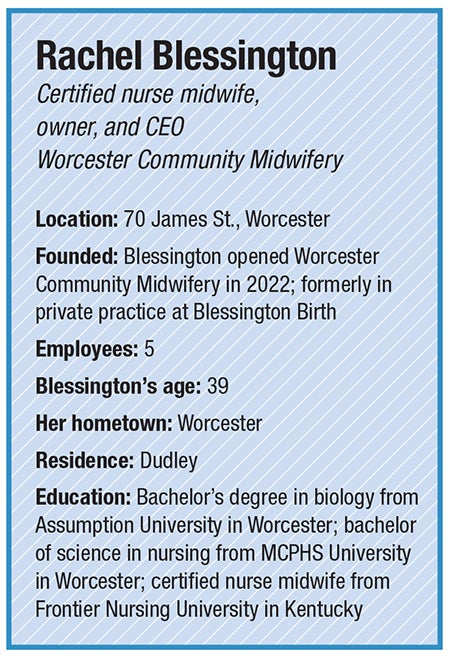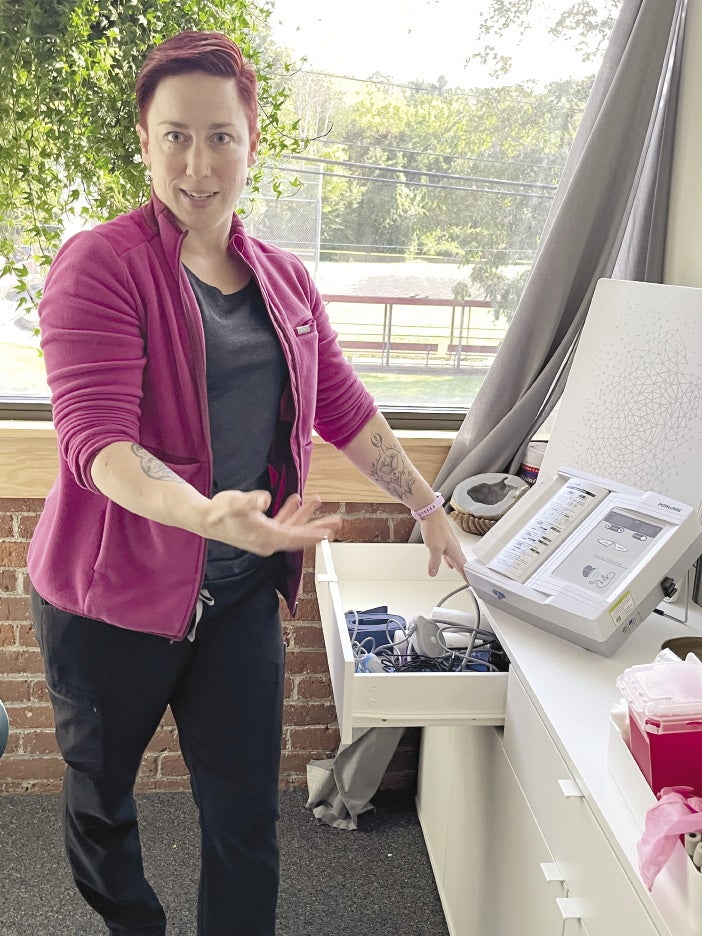Blessington sees collaboration and outreach as an integral part of her practice at Worcester Community Midwifery.
Get Instant Access to This Article
Subscribe to Worcester Business Journal and get immediate access to all of our subscriber-only content and much more.
- Critical Central Massachusetts business news updated daily.
- Immediate access to all subscriber-only content on our website.
- Bi-weekly print or digital editions of our award-winning publication.
- Special bonus issues like the WBJ Book of Lists.
- Exclusive ticket prize draws for our in-person events.
Click here to purchase a paywall bypass link for this article.
It would be understandable if certified nurse midwife Rachel Blessington wanted to keep her head down in the busy work of delivering babies and caring for women. With options for prenatal and maternity care shrinking locally and nationally as hospitals close maternity services, the steady business of childbirth is more than enough to fill a day.

But Blessington sees collaboration and outreach as an integral part of her practice. Over the summer, she opened the offices of Worcester Community Midwifery. There she sees patients for office visits for prenatal and reproductive health care, while delivering babies in their homes. (Fun fact: Her grandparents once operated an electrical contracting business at the same location.) Meanwhile, she’s participating in the current Leadership Worcester cohort, a nine-month networking program meant to propel shape the next generation of Worcester leaders.
Community-based midwifery is a bit of a square peg in a round hole in the U.S. healthcare system. Only 2% of U.S. births happen outside the hospital, and just 11% of all births were attended by a midwife, according to a May 2023 report by The Commonwealth Fund. Blessington and her colleagues see it as a viable option for the majority of expectant parents. Blessington plans to open a birth center in Worcester in the coming years and seeks to build relationships with other maternity care providers and schools in order to solidify the practice as a place where people can get integrated health care.
How did you end up a certified nurse midwife?
I started out teaching in the Worcester Public Schools, and then I took a seminar in midwifery. I had a biology degree and training in massage therapy, and it felt like a great empowering way to use art and science. I went back to school for a second bachelor’s degree in nursing and started attending births as a doula. After graduating, I got a nursing job in labor and delivery and started apprenticing as a homebirth midwife. I had exposure to both hospital and community birth.
I loved working in homebirth as a certified professional midwife, but it seemed to expand my scope, I really needed to become a certified nurse midwife.
The vast majority of babies are born in the hospital in Massachusetts and nationally. How does community midwifery fit into the picture?
We have so much data the midwifery model of care – integrated into the healthcare system – has better outcomes at a better value than a system offering only hospital birth. It's so important we have midwifery care as part of the basis of maternity care, like other high-income countries that use midwives and have better outcomes than the U.S.
The style of care has been shown to reduce the disparities between different ethnic groups. Creating a community practice and then a birth center, that's part of the local system and will still only serve a small portion of the population. But besides creating choice, it’s a place where people can receive education in midwifery care, doula care, and lactation services.
Who is a good candidate for your services?
The majority of people are good candidates for midwifery care, if they choose that. If they need to be referred up, we are collaborating with our obstetrical colleagues.
There's just one community birth center, unaffiliated with a hospital, operating in Massachusetts today. Is such a birth center imminent in Worcester?
Everything we are building with this practice is with the goal of opening a birth center. We are a developing member of the American Association of Birth Centers. It falls under a health center regulated by the Massachusetts Department of Public Health. There are hundreds of pages of guidelines you need to meet to become a facility. Requirements vary, state to state. In Massachusetts, you have to meet the standards for an outpatient clinic.
Does insurance cover your services?
Virtually no insurance company will pay for homebirth, but some will reimburse for prenatal and postpartum care. Clients can apply for reimbursement for out-of-network care.
What are the other barriers to midwifery care?
Midwives are the obvious and natural entryway for pregnant people to get care, but in the U.S. we make it almost impossible for someone to become a midwife outside the hospital setting. It takes a lot of support, and there are insurmountable barriers for many people. Those are things that are being worked on in the state legislature. There’s a pay disparity, but there is legislation pending to reimburse midwives and doctors the same amount for deliveries.
It’s shifting, but it's slow. There's a lot of resistance. The No. 1 driver is the consumer; the clients becoming aware.
This interview was conducted and edited for length and clarity by WBJ Correspondent Emily Micucci.
CORRECTION: A previous version of this article incorrectly referred to Rachel Blessington as a certified practicing midwife. The correct term is certified professional midwife.

